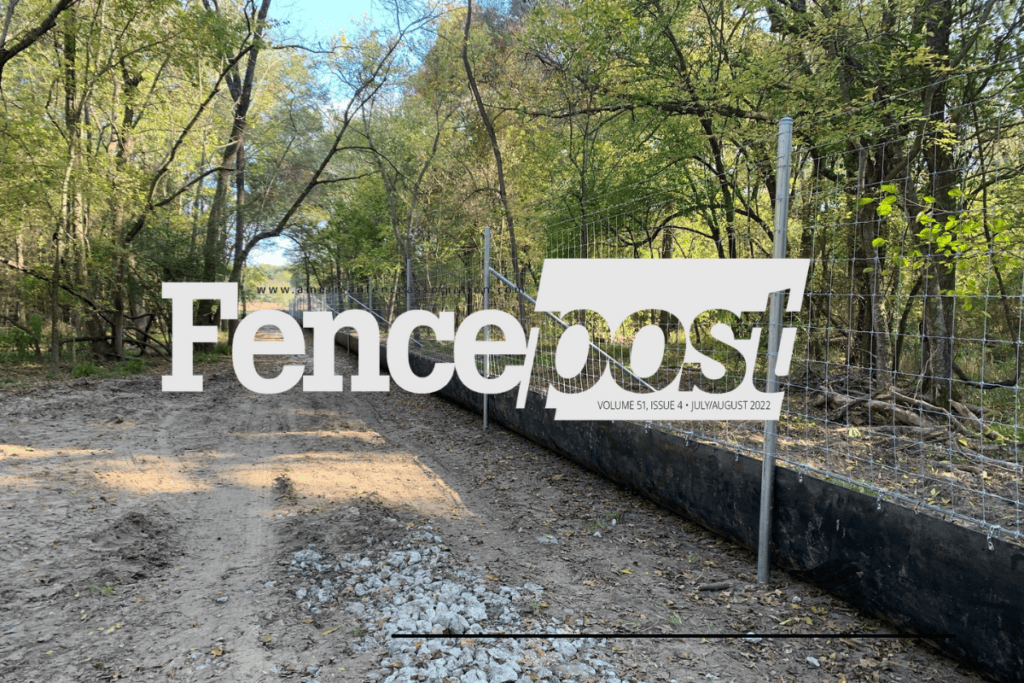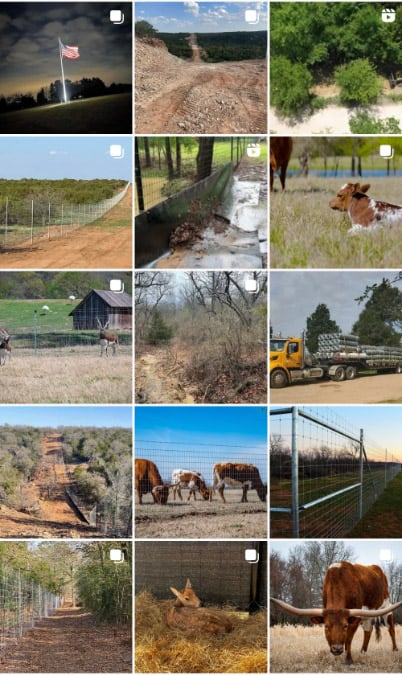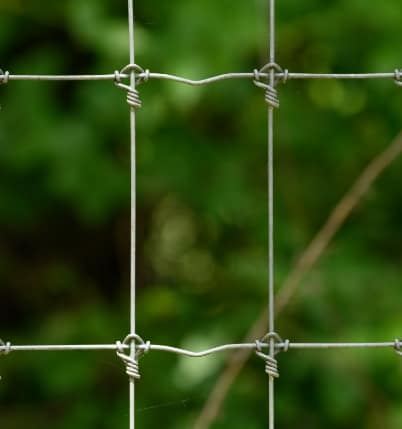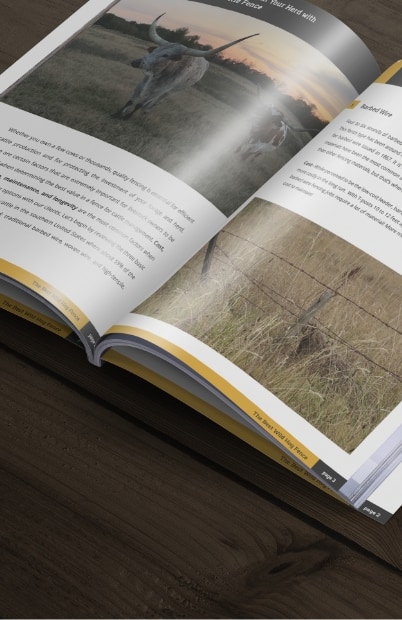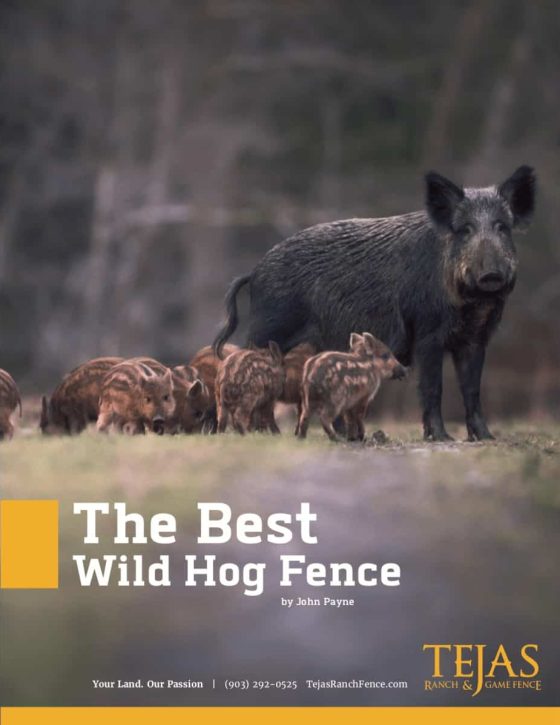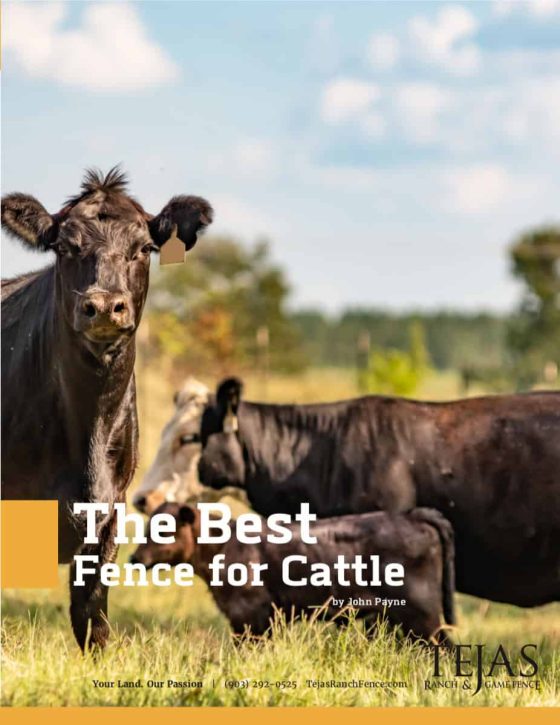Tejas Ranch & Game Fence was recently featured on the cover of the American Fence Association’s Fencepost Magazine for its water gap fencing solution. Read the full article below about water gap fencing best practices.
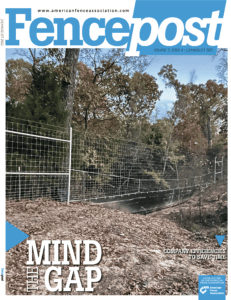 Fencing for farm and ranch situations where the field has a body of water running through it has always been a challenging situation no matter where you are located.
Fencing for farm and ranch situations where the field has a body of water running through it has always been a challenging situation no matter where you are located.
If your fence line crosses a body of water — be it a stream, creek, or river — installing water gap fencing helps to ensure that your farm animals cannot escape, while also acting as a floodgate that allows water and other items to continue to flow through.
American Fence Association member Tejas Ranch & Game Fence of Athens, Texas knows all about water gap fencing on a rural property, having provided many companies with different types of ranch fence construction for more than two decades.
The company emphasizes that when constructing water gap fencing on a rural property, the most essential element is ensuring water flow while maintaining an effective barrier.
Water gaps are important to maintaining the integrity of the fence enclosure, but do add cost to a project.
“For example, the number of waterways crossing the fence line will increase the high fence cost equation,” explains John Payne, president of Tejas Ranch & Game Fence.
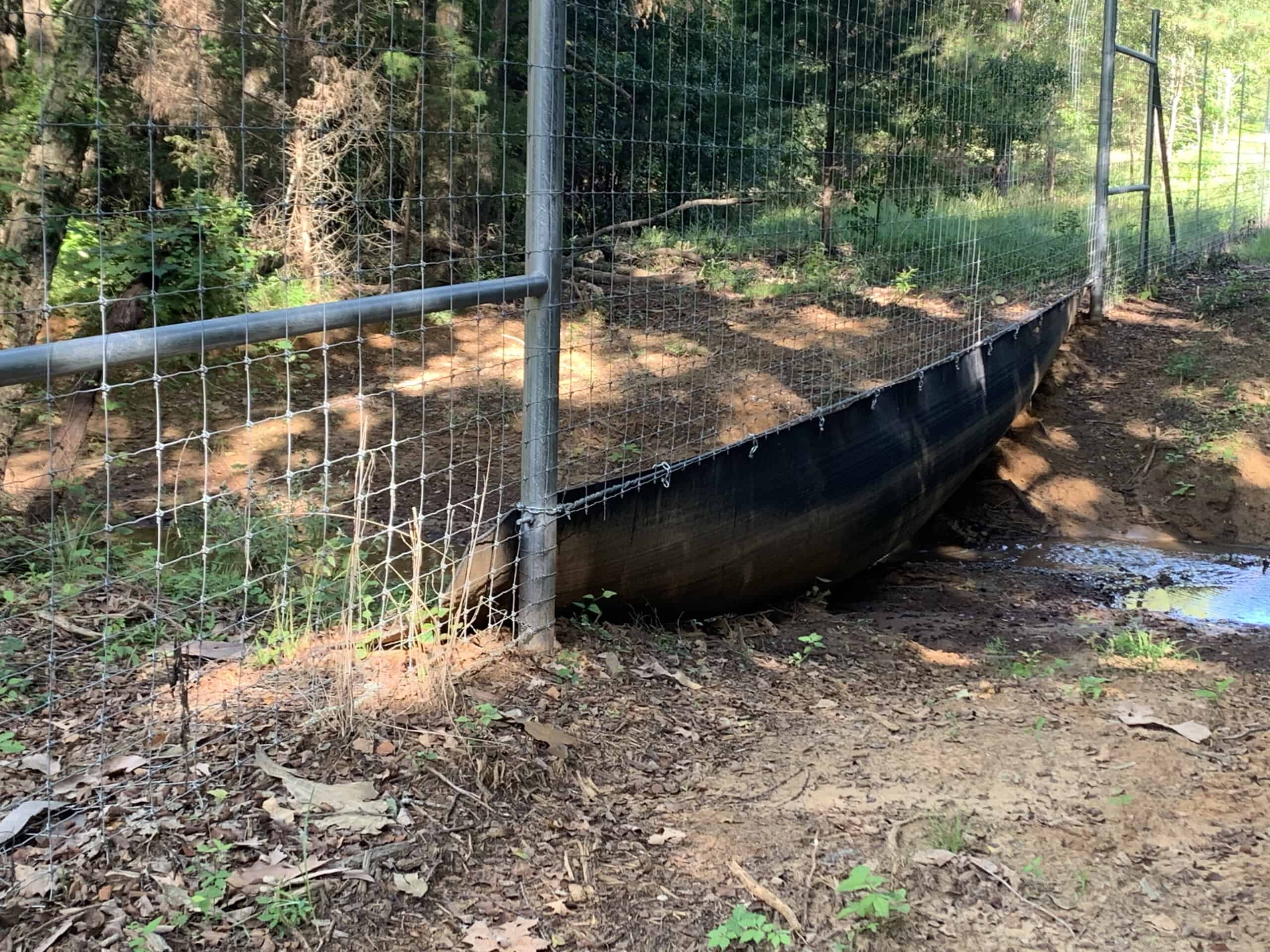
“Simply stated, high fences keep animals from passing from the inside out and the outside in. How can this barrier be achieved when creeks, rivers, and other water features cross the fence line? A water gap fence system is the answer.”
When water levels are low, properly designed water gap fences will essentially “close the gap” and keep animals from passing through the waterway. When water levels are high, the water gap fence will “rise up,” allowing flowing debris such as sticks, limbs, leaves, grass, and other vegetation to pass through. If debris is unable to pass, it gets caught in the wire mesh of the fence material and creates conditions that can lead to fence failure.
“We’ve all been there,” says Payne. “A good rain comes and you’re checking water gaps at the earliest opportunity. If you are lucky, you don’t have any cleaning out to do. But maintaining a clean water gap is key to its ability to work properly.”
The company has devised an advanced water gap system that works not only when it rains, but also when it is dry. And, most importantly, it allows debris such as logs to pass through.
“Unlike heavy metal fence structures suspended on hinges, the Tejas’ Floatmaster water gap system employs rubber mats that rise and float when it rains, allowing logs and other debris to pass under the fence without pressure on the structure,” explains Payne.
“When it is dry, the rubber mats are pliable enough to contour to the ground and seal the gap from the animal breech. Easy to maintain, the Floatmaster water gap system continues the integrity and protection of a fence enclosure over waterways and is crucial to project success. Because of the revolutionary design, high-quality materials and expert installation of this system, this water gap fence system resists clogging and forms a reliable seal when closed.”
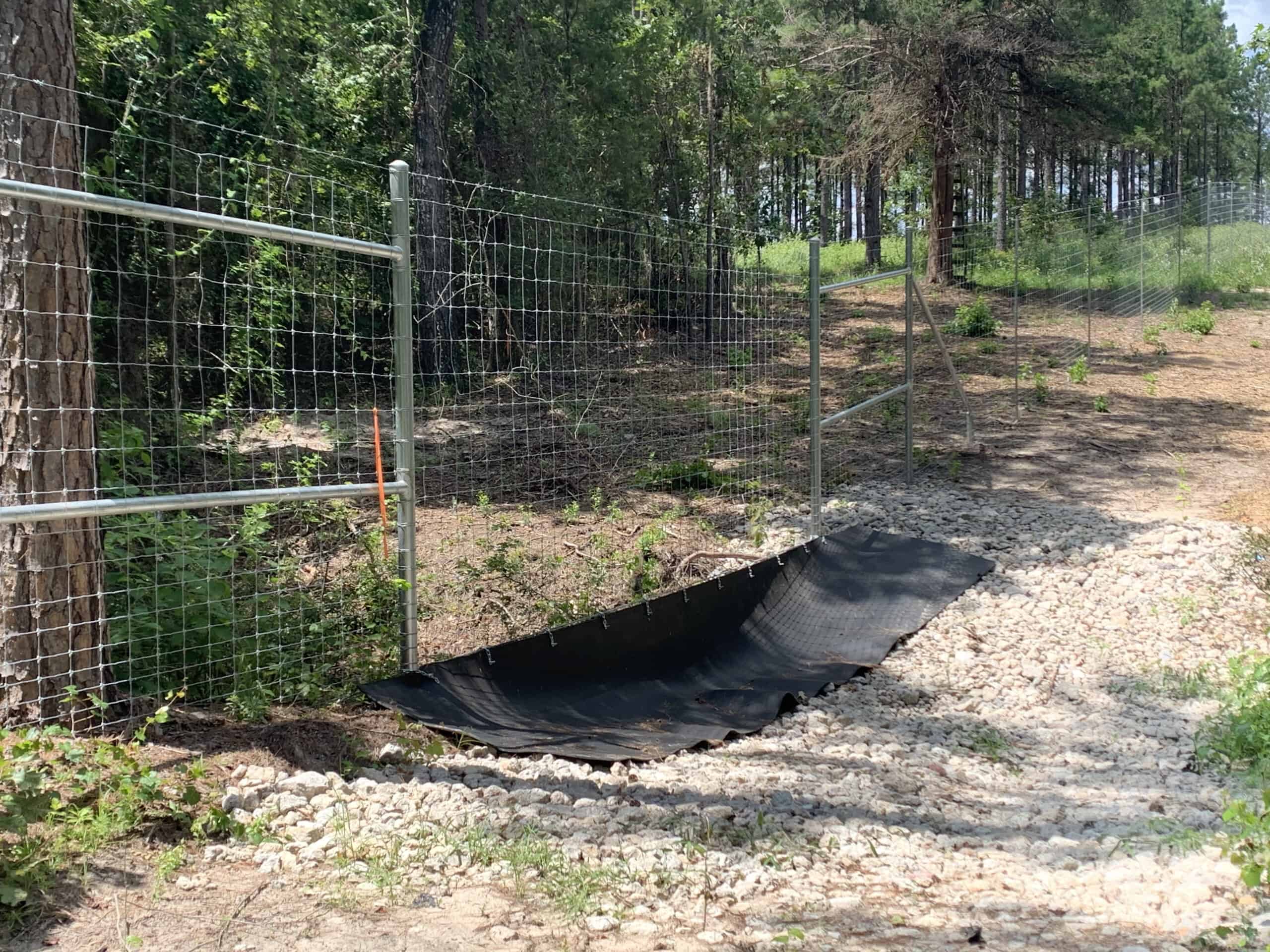
WATER GAPS – WHAT TO CONSIDER
When considering your plan for a water gap fence, there are a number of factors to think about, such as what materials work best.
Mark Harrington is the manager at Binford Supply Co. in San Antonio, Texas, a fence supplier with numerous locations in Texas and Oklahoma. He says they often see galvanized schedule 40 pipe or heavier framework with galvanized fittings and infill used.
“Many of the owners use 4-inch O.D. schedule 40 pipe to 8 5/8-inch pipe for the posts. The size of the span you need to cover and the type of soil you are in will help determine the diameter of the pipe, as well as how deep the posts need to go in the ground.”
He adds that while many products can be used for water gaps, what his team mostly sees are fences that span the gap between the banks on top of a piece of pipe with panels hanging below the pipe to allow water and debris to flow through.
“Woven wire being used on the top part of the fence is fine. However, for the part that will be in the water, it would be better for it to be rigid steel panels or high tensile wire so it can withstand the strength of current and debris with minimal repairs.”
To ensure animals on your property cannot jump over the fence, its height largely depends on how deep the gap is and the steep of the grade coming into it.
“Keeping the fence close to level with the bank is normal, and you have the panels hang below just above the ground, so they act as the fence when there is no water present,” Harrington explains.
“Also, electrifying the fence probably is not the best option with water gaps as you could have some shorts in the wiring when large amounts of water are flowing through. The electrifying of the fence typically does not hurt the animals as it is low voltage.”
Other considerations to take into account relate to changes in elevation and potential mud and unstable post foundations.
Harrington emphasizes that post footings need to be set back enough so they are not compromised when the soil is saturated with moisture or drought conditions. Typically, the fence will be close to level with the banks of the water gap and have gate panels hanging down to close the gap where the water flows.
“The larger span of water you need to cross, the bigger the diameter of posts and footings will need to be. And, in the cases where there is an extreme span, there may be a need to place a post in the water gap to help with support, but this is kept to a minimum because you do not want the posts to be hit by debris.”
With respect to what measures should be taken into consideration for debris — such as sticks and branches — that could become lodged in the fence, it is imperative that gate panels hanging down into the water gap be heavy enough to act as a fence. When there is no water, the gate needs to be able to swing up when the current is strong enough to push them up. This will allow debris to flow through and, hopefully, not cause any damage to the fencing or framework.
“Once the water has receded, it is important to check the gaps to make sure the gates have closed completely,” he adds. “Sometimes debris might get stuck in the gate panels and will need to be cleared for the gate to completely close.”
While water gap fencing is a “no one size fits all” option for all properties, most reputable fence suppliers will stress the importance of considering soil conditions, depth and width of moving water, the water source and its distance from your property, and the amount of debris that could get stuck and cause damage.
Bo Pierce is president of Alabama Game Fence located in Camden, Alabama. He believes in educating their clients on the importance of utilizing water gaps in their fence systems. The company specializes in agricultural and game fencing throughout the Southeast and has installed miles of water gaps. They are often called to come in and consult on existing water gaps that have failed for one reason or another.

He says a great deal of research goes into determining how to utilize water gaps when fences are crossing bodies of water, or low-lying areas prone to floods. The goal for the team is that after installing a water gap, they don’t have to go back and repair it.
“We build it one time and it’s there for the duration of the fence. We don’t want to go back and have to fix it because we didn’t do our homework.”
In areas where clients have livestock, his team often uses water gaps in low-lying areas where creeks back up into the property. Without the water gaps being installed in these locations, the fence is subject to being torn down by rising flood waters and debris created by the flood waters. This can cause major problems for cattle operations or deer preserves.
“Depending on the situation for cattle operations, we will run the fence at the normal 49-inch height,” Pierce explains. “We then cut the bottom 24 inches of the fence out and run 30-inch rubber in place of the 24-inch wire we cut out allowing for approximately six inches on the ground in the direction of the water flow. When the water rises, it lets the debris through. And when the water recedes, the rubber lays back down. We often utilize extra bracing off of our line posts in these areas as well to help with the structural integrity of the fence system.”
His team also does not use multiple vertical sections of rubber. Instead, they will generally use just use one horizontal piece of rubber — that is typically 30 inches tall — and run it horizontally 24 inches off the fence and six inches on the ground, for low-lying areas or flood-prone areas of the fence line.
When crossing creeks with the fence, Pierce says, “You don’t want your fence in the water if possible. We study high water marks, and we start the fence 10 feet to 12 feet back from these marks. That is where we begin the water gap. The fence stays at the same elevation across that opening so that animals cannot get through. The fence remains the same elevation, but the water gap is a completely different system than the fence system. We separate the two so that — if in the event the fence gets torn out over the water gap — we are only replacing a small section of fence instead of a long run of fence.”
When it comes to ensuring that debris doesn’t get stuck, it’s important to ensure that the rubber is overlapped by six inches and overlapped against the way the water flows.
“If the water is flowing inward and has a slight turn to the right, you’ll then want to overlap everything to the left so that debris runs off the rubber and doesn’t get trapped with the overlap,” he adds.
“With water gaps, you really have to study the water flow before you start building and installing the fence. You also have to evaluate the situation and determine how far from this body of water that you are going to start the water gap, and know which way the water current brings the trash.”
No small task.
The original article appeared in the American Fence Association’s Fencepost Magazine.
